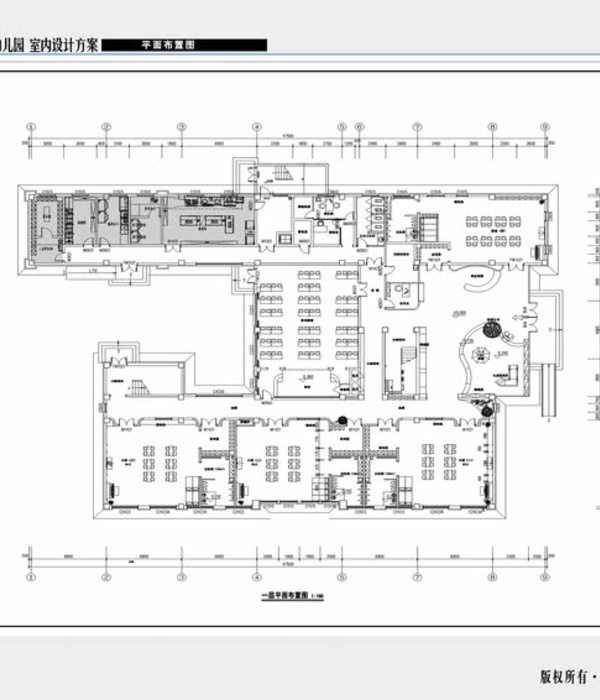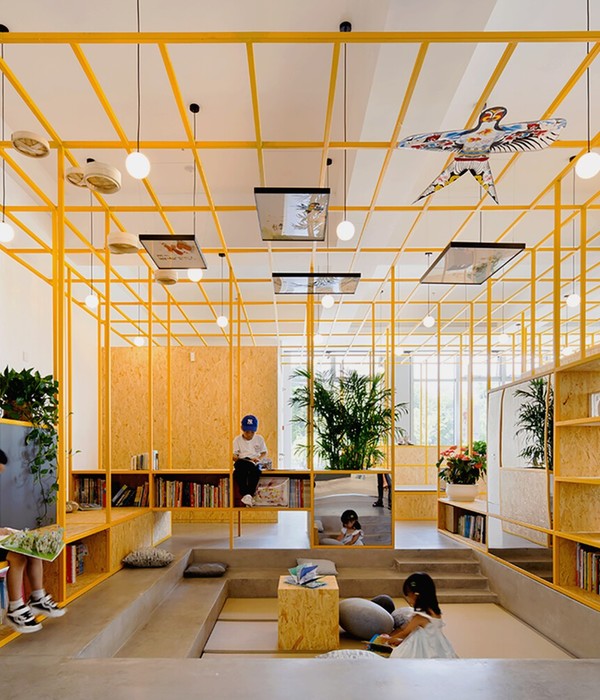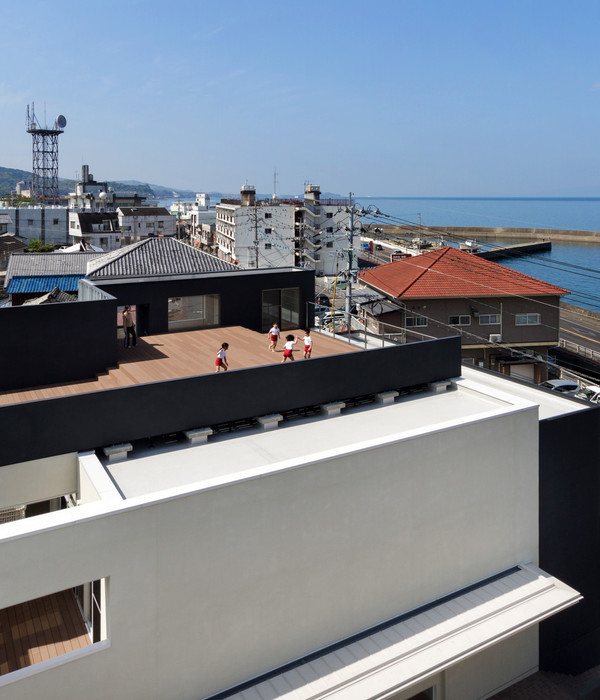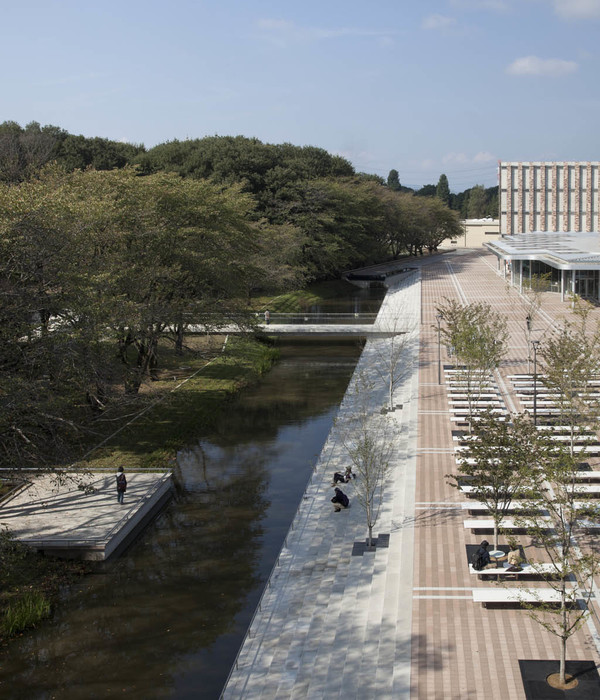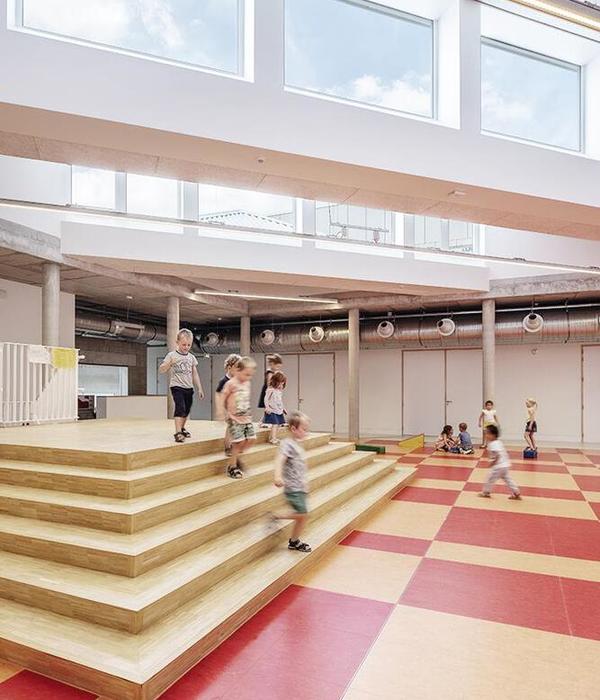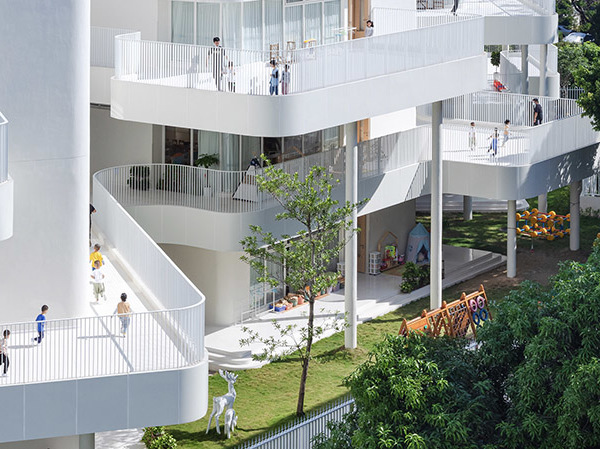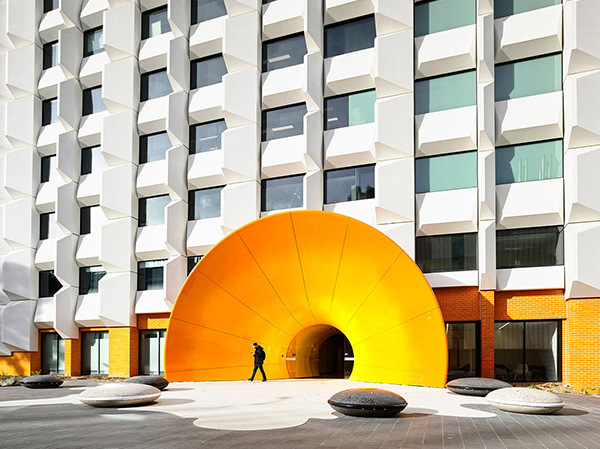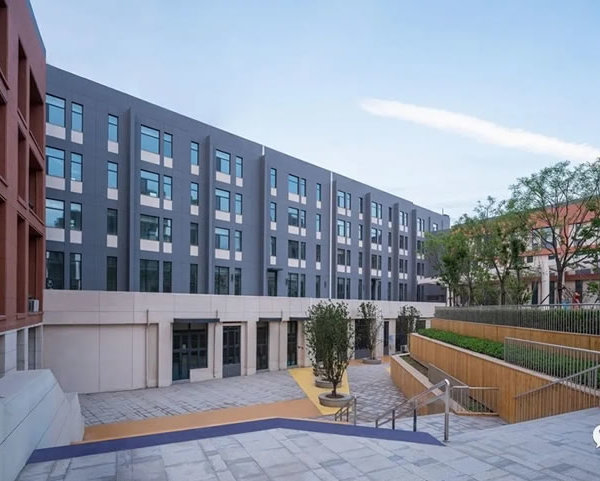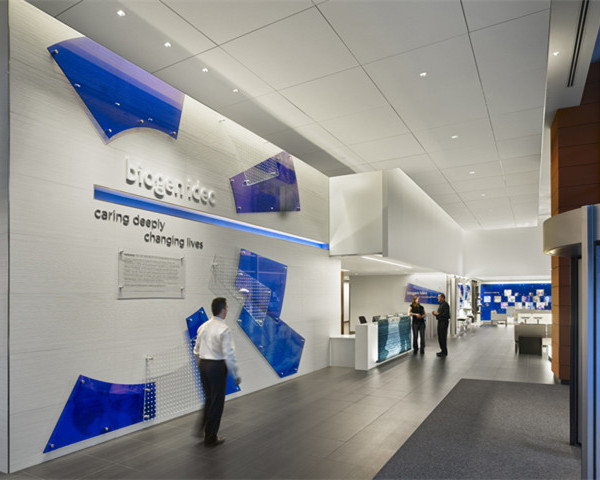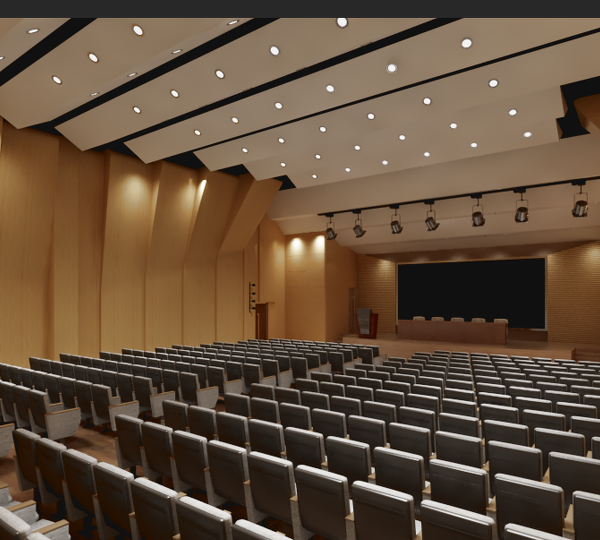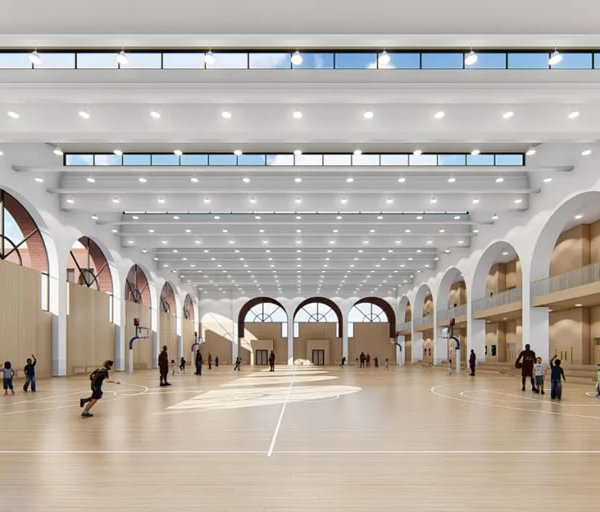项目历史 | Project History
该项目是一座在非政府组织Iran-e-Man的倡议下以可持续方法建造的小学。该组织在学校建设方面拥有数年经验,此次是受Seyedbar-Jadgal村庄(距离Chabahar100公里)的委托来打造新的学校。建筑师团队和项目的推进方自发地对该项目的设计和施工进程实施了监督。
The project is a public call for the Construction of a school with a sustainable development approach by a non-governmental organization called Iran-e-Man, which has been working in the field of school construction for several years. On the other hand, the request of the people and youth of Seyedbar-Jadgal village (100 km from Chabahar) from this institution to build a school in their village. As a result, the architectural design team and project facilitators voluntarily began designing and supervising the project construction process.
▼项目概览,Overall view © Deed Studio
▼学校外观,Exterior view © Deed Studio
项目开始时,团队在村庄和周围地区进行了为期数月的建筑和社会研究。通过参与的方式,团队确定了村庄和原住民的各项需求、不足之处以及发展的潜力,并对其进行了详细定义和优先排序。
考虑到该项目在预算上的有限,且只能依靠捐助进行建设,设计团队并未采用“修建和捐赠”的方案,而是通过参与式的建设方法来促进可持续发展,打造具有社会性、经济性和文化性的基础设施。
学校的愿景是成为村庄及其附属社区的发展中心,因而它除了作为孩子们的教育场所之外,也将为每个村民提供聚集和学习的空间。
Initially, the team carried out architectural and social studies in the village and the region for several months. In a participatory way, the needs and shortcomings, potentials and capacities of villages and indigenous peoples were identified, themed and prioritized.
Considering that this project had a limited budget and was to be built only by people’s donations, we did not plan “a build and donate” scenario and instead opted for a participation method of Construction that would promote sustainable development and produce social, economic, and cultural infrastructures.
As a result, we designed a school with the idea of becoming the village and its dependent communities’ development center. In this way, the school was a place of education for children and a point of gathering and learning for everybody in the village.
▼场地鸟瞰,Aerial view © Deed Studio
▼周边环境,The context © Deed Studio
为了实现以上目标,项目团队在与社会推动者的合作下开展了一些基础性的工作,例如以小组形式邀请村民维护村内的卫生和清洁、修建污水处理池,以及成立缝纫工坊(Instagram主页:@Banook)以展示和销售针织产品等。这样一来,村里的妇女也得以投身到社会活动当中,从而提升了她们在当地的经济和社会地位。
此外,为了配合社会参与的建设方法,许多村民作为工人参与了学校的修建,而他们的家庭也通过售卖刺绣产品为项目提供了经济上的支持。最终,学校在公众的齐心努力下建成,并赢得了每一位村民的赞誉。
In order to materialize this idea and in cooperation with social facilitators, some fundamental works such as doing group work, inviting villagers to maintain the hygiene and cleanliness of the village, building septic sewage, and setting up a needlework workshop and an Instagram page -called @Banook to showcase and sell needlework products- were undertaken.
In this way, the women of the village were engaged in social activities. However, it also promoted their presence in the social and economic realms of the village and helped women to be socially seen as more effective.
In addition, in coordination with the social participation method of development, people of the village helped by working as site labourers to build the school. But that was not all they did as the village families contributed financially and helped by selling needlework for the school to materialize.
This way, the school was built by public participation and gained the goodwill of everyone in the village.
▼校园围墙近景,The enclosure wall © Deed Studio
▼围墙鸟瞰,Aerial view to the enclosure wall © Deed Studio
目前,学校除了作为教学场所外,还提供一些额外的功能,例如在节假日和夜晚用作儿童的游戏场地,或为村民及其家人提供聚会和集体观影的场所,以及足球场、图书馆和旅馆等等。
学校由村民和教师组成的团队进行管理。从旅游和针织品得到的部分收入将用于学校的维护。通过这种方式,学校真正实现了由村民建设、由村民管理。
At present, apart from the educational function, this school has other functions such as a children’s play area on holidays and nights, a gathering place for villagers and their families, a place to watch movies and football in groups, a library, and a tourist residence. The school is managed and maintained by a team of villagers and teachers, and part of the income from the tourism and needlework sections is spent on its maintenance. In this way, the school is built with the participation of the villagers and is eventually maintained.
▼中央庭院,Central yard © Deed Studio
▼外围环形空间,The circular space around classes © Deed Studio
▼从外部望向环形空间,View to the circular space from outside © Deed Studio
项目描述 | Project Description
学校占地470平方米,只有一个楼层,包含了四个小学班级(可以合并或叠加)、一个图书馆、一个可作为会议室、工坊或考场的多功能厅,以及不同大小的活动庭院——其设计目标是成为村庄社区中心,起到教育全体村民的作用。
▼平面图,Plan © Daaz Office
Seyedbar Village’s school, covering 470 sqm in one floor, consists of four elementary classes with the ability to combine and overlap with each other, a library, a multi-function hall working as a conference room, workshop, or exam hall, and main and secondary play yards that are designed while aiming to become the village’s community center and educate its whole population.
▼主庭院,The main yard © Deed Studio
▼教室与围墙之间的空地,The space between classes and the wall © Deed Studio
▼外部视角,View from outside © Deed Studio
设计团队考察了学生与教师之间的相处模式,同时考虑到学校的改造规范,最终设计了四个班级空间。
每两个不同大小的班级相互连接,其中大的班级包含一个中间场所,可以让低年级的学生加入大班,以充分发挥单个教师的教学效率,一方面缓解了教学人员短缺的问题,另一方面也为不同年级的学生提供了接触和交流的空间。
Considering the population of the students in relation to teachers in this village, and through adhering to school renovation codes, the school needed four classes. In designing the classes, each two-class varying in size were connected to each other.
In the largest category, there is an intermediate space that enables the younger students to join the larger class, taking advantage of the training of one single teacher, necessary due to the limitation of teaching personnel, as well as giving them a space to engage with senior students.
▼教室布局示意,Classroom – diagram © Daaz Office
▼教室内部,Classroom © Deed Studio
材料,建造和技术 | Material, Construction And technology
为了符合伊朗立法和管控机构制定的改造规范,同时满足必要的抗震性,学校的结构采用ICF(隔热混凝土模板)方法建造。借助聚苯乙烯板(EPS)、镀锌铁型材和钢筋混凝土,该结构在没有设立任何柱子的条件下得以实现——这也得益于建筑的曲线型形式。
最后选用的涂层是一种由水泥和当地土壤组成的名为“Simgel”的材料,它能防止由洪水和降雨引起的生锈,并与周围环境的色彩和肌理形成和谐的关系。此外,在损坏或开裂的情况下,这种材料也可以很容易地由村民进行修复。
▼立面图,Elevation © Daaz Office
In alliance with the school renovation codes by the Legislative Institution and Control of School Construction in Iran and the necessity of building earthquake-resistant structures, the school’s structure was constructed with the ICF method, Insulating Concrete Formwork. By utilizing polystyrene panels (EPS), galvanized iron profiles, and reinforced concrete, the structure was constructed without any columns- thanks to the design’s curvilinear forms.
The final coating layer that was applied is a semi-local material consisting of cement and local soil called Simgel that prevents rusting due to floods and excessive rain and creates harmony with the surrounding colours and textures. And In case of destruction or cracking, it can be easily repaired by the villagers.
▼开放的界面,The open interface © Deed Studio
意义与影响 | Project Significance and Impact
操场的圆形形式和班级的布局方式共同体现了学校在教育上的核心理念:“共同学习”——没有等级差异,且充满自由的气息。“转动”的平面布局和相互连接的角落使空气得以在班级之间流通,同时也创造出了数个面积更小一些的庭院,可用于小组作业和户外活动。这样的布局也使校园拥有了一个位于中央的主庭院,用作学生和村民的集会场地;而班级与带有圆洞的围墙之间,则形成了一个连续的环形空间和多个私人庭院。
▼轴测分解图,Axon exploded © Daaz Office
The circular form of the schoolyard and the way classes are arranged formed with the focal concept of education, meaning “learning together”- void of hierarchical systems and in a democratic style.
The rotation of the class layout while connecting them on their corners allows for air circulation between the classes and produces small secondary yards for doing some group work and outdoor activities.
Consequently, with this spacial diagram, we gained a central primary yard in the middle of the school as an assembly point for school children and village residents, a circular space around classes and between the thick penetrated wall and classrooms, as well as private yards.
▼“转动”的平面布局和相互连接的角落使空气得以在班级之间流通 © Deed Studio
The rotation of the class layout while connecting them on their corners allows for air circulation between the classes.
▼班级与带有圆洞的围墙之间形成环形空间和小庭院 © Deed Studio
A circular space and smaller yards are created between the thick penetrated wall and classrooms.
围墙通常被理解为保护和分隔的要素,一般呈现为由砖石砌筑的防护结构。但在该项目中,得益于学校所处的相对平坦且广阔的场地环境,围墙被设计成了一个可穿行的、充满吸引力的游戏外壳。墙上的洞口是基于学生坐在教室里的视野而设置的,可以直接看到远处的平原。
不同尺寸和形状的圆洞为学生提供了进入校园的不同入口。与此同时,通过增加墙壁的厚度,一些基本的功能空间得以被容纳在建筑中,例如小卖部、学校警卫室和储物间等。主入口被特别强调并被赋予了吸引人的深度。
▼入口路径示意,Access – diagram © Daaz Office
The concept of a surrounding wall is traditionally understood as protector, separator and generally stands for a masonry built guarding device. In this project, however, through the school’s unique location, being in the middle of a relatively flat vast field, the school wall was treated as a penetrated inviting playful shell.
The openings within the wall are arranged so that from the point of view of a seating person in the class, the extension of the surrounding plain can be seen. Having various sizes and shapes, these openings provide students with multi entrances to arrive at the school.
Moreover, by increasing the thickness of this continuous yet penetrated wall, some essential functions of the building such as a tuck shop, a school guard’s room, and a storeroom were housed while the main entrance was emphasized, gaining depth and inviting people within.
▼不同尺寸和形状的圆洞为学生提供了进入校园的不同入口 © Deed Studio
Having various sizes and shapes, the openings provide students with multiple entrances to arrive at the school.
▼入口细节,Entrance detailed view © Deed Studio
▼可穿行的、充满吸引力的游戏外壳, The penetrated inviting playful shell © Deed Studio
在设计这所学校时,项目团队将教育设想为一个辩证的、双边的、具有参与性的概念,并试图让承载这一概念的传统校园空间发生改变:学校的墙从“分隔物”变成了一个可渗透、可游玩的开放式“表皮”,邀请人们汇聚于此,从而鼓励社区文化并加强人与人之间的交流。 这种改变正是为了打破等级、鼓励质疑,强调教育的基本意义,那就是“在一起”。 总而言之,设计的目标是让学校成为培养创造力、自由和批判性思维的园地。
In designing this school, we envisioned education as a dialectic, bilateral, participatory driven concept and accordingly, the conventional school spaces that act as platforms of these ideas were transformed in this manner: converting school wall from “separator” to a shell structure that performs as a penetrated borderless playful skin that invites people to gather and encourages the community culture while reinforcing communication between people.
This transformation was performed in order to destroy hierarchy and strengthen questioning culture, shining light on the most basic meaning of going to school, which is “being together”. In conclusion, we aimed to create a school that is a nest for nurturing creativity, freedom and critical thinking.
▼学校夜景,Night view © Deed Studio
▼围墙开口示意,The wall – diagram © Daaz Office
▼剖面图A-A,Section A-A © Daaz Office
Jadgal Elementary School
Lead Architect: Arash Aliabadi Client: Iraneman Organization Project Architects: Mahsa Hosseini, Nazanin Mojahed Social Facilitator: Mina Kamran Structure Design: A.Giahi Project Manager: Mehran Goodarzyar Contractor: A.Noghrehkar Mechanical & Electrical: A. Delavar Photo Credit:Deed Studio
{{item.text_origin}}

